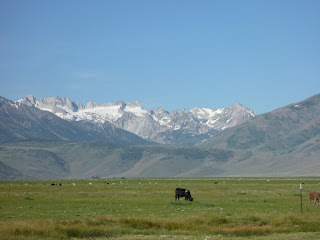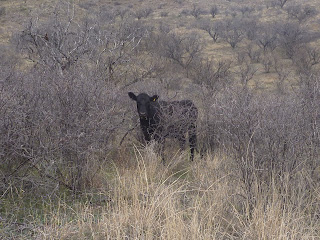Let's lead into this with my experiences with the iconic meat animal, the cow. I go way back with cows.
Cattle ranching is a ubiquitous feature of the American Southwest. All my field work as an undergraduate and a doctoral student was on range I shared with cows. We're within running distance of a large ranch where we routinely hang out with cows, and my wife has photographed the round-up. She's helped with a round-up on horse-back on another ranch. This shy girl was photographed in the arid Owens Valley in California on my way to the Death Ride.
It's well-known amongst biologists that large-scale ranching, especially beginning in the later part of the 19th Century, damaged the desert grasslands of the Southwest badly. The grass has largely disappeared and been replaced by arid land adapted shrub and tree cover as species like mesquites moved out of the washes when cows ate their pods and spread the seeds in their droppings.
Here's a comparison of the lush 6000 foot elevation Bridgeport Valley at the foot of the Sierras in Callifornia and the 4500 ft elevation Canelo Hills area in southeast Arizona. Click on the photos for larger images.
By the way, do you notice the solar panel next to the old windmill? Solar panels are commonly used with cattle tanks these days. Can you imagine being the poor calf that has to eat and grow on this poor forage? Notice the not-yet-leafed-out mesquites all around in mid-April.
And therein lies the tie to oil supplies. Cows from the marginal rangeland are rounded up and trucked to feed lots far away from the range. Our neighbors use horses for round-up, but trucks and ATVs are very commonly used these days. I can't think of any feedlots close to our neighbors, so that's a significant transport of many thousands of pounds of cow. Then those cattle are fattened up on corn from mechanized farms in the Midwest that's transported across the country. Then the cattle must be hauled to slaughterhouses, executed, processed, and the meat hauled to its destinations.
Ranching is already marginal in the modern Southwest. A friend of ours who's family has ranched for generations in the Sulphur Springs Valley tells us even now cattle ranching isn't really sustainable. No one has yet suggested goats, which eat anything. And worse, the Southwest is drying. Increased desertification is likely. Here's a striking view of Lake Mead behind Hoover dam, which will go dry in a decade or so at current usage rates.
Combine this with the imminent decline is oil production; as fuel costs rise, most ranchs in the Southwest could fail. While in other writings I've talked about the collapse of mechanized agriculture, I hadn't thought out how precarious my neighbors' livestock enterprises are. And this is likely to be exacerbated by horrible credit problems as the lending entities hunker down. For my part, I'm planning to learn how to harvest and process mesquite pods, which we can eat instead of the cows. I just counted 16 trees near the house and a similar number by the arroyo. A decent-sized mesquite is supposed to produce 20 pounds of mesquite flour per year.
Bringing this back to the science establishment, I came to a realization while I was running in Saguaro National Park this morning. I've been frustrated because researchers aren't trying to analyze the effects of the world's declining energy budget on agriculture, food supplies, and populations. Unfortunately, researchers and planners haven't yet grasped that people will be eating what they can get, not making choices. Eating locally and eating less meat won't be optional. Starvation on a scale we can't easily imagine is a real possibility.
My psychologist friend Brian attributes the current state of mind to denial on the part of most people. Scientists are just as capable at kidding themselves as anyone else. That's part of the point of peer-review. But I think there's a different problem as well. In my experience, life scientists are very good at burrowing into their specialities. They don't want to think about political, social, and economic problems. A decline in the general energy budget of the society they are embedded isn't something they are well-equipped to study. Even for the applied researchers studying food and populations, decades of low fuels costs have conditioned them not to think about oil supplies. Like oil supplies, population growth has seemed infinite and they don't realize that there's a causative relationship.
At some point, and soon, reality will intrude. When will scientists working beyond the narrow specialities of petroleum geology start to talk intelligently about the matter? What will the projections look like? How will the general public react? Expensive and unobtainable fuel, combined with frozen credit as people sit on their money, is much harder to deny than faraway peoples coping with the reality of climate change.
Ranching is already marginal in the modern Southwest. A friend of ours who's family has ranched for generations in the Sulphur Springs Valley tells us even now cattle ranching isn't really sustainable. No one has yet suggested goats, which eat anything. And worse, the Southwest is drying. Increased desertification is likely. Here's a striking view of Lake Mead behind Hoover dam, which will go dry in a decade or so at current usage rates.
Combine this with the imminent decline is oil production; as fuel costs rise, most ranchs in the Southwest could fail. While in other writings I've talked about the collapse of mechanized agriculture, I hadn't thought out how precarious my neighbors' livestock enterprises are. And this is likely to be exacerbated by horrible credit problems as the lending entities hunker down. For my part, I'm planning to learn how to harvest and process mesquite pods, which we can eat instead of the cows. I just counted 16 trees near the house and a similar number by the arroyo. A decent-sized mesquite is supposed to produce 20 pounds of mesquite flour per year.
Bringing this back to the science establishment, I came to a realization while I was running in Saguaro National Park this morning. I've been frustrated because researchers aren't trying to analyze the effects of the world's declining energy budget on agriculture, food supplies, and populations. Unfortunately, researchers and planners haven't yet grasped that people will be eating what they can get, not making choices. Eating locally and eating less meat won't be optional. Starvation on a scale we can't easily imagine is a real possibility.
My psychologist friend Brian attributes the current state of mind to denial on the part of most people. Scientists are just as capable at kidding themselves as anyone else. That's part of the point of peer-review. But I think there's a different problem as well. In my experience, life scientists are very good at burrowing into their specialities. They don't want to think about political, social, and economic problems. A decline in the general energy budget of the society they are embedded isn't something they are well-equipped to study. Even for the applied researchers studying food and populations, decades of low fuels costs have conditioned them not to think about oil supplies. Like oil supplies, population growth has seemed infinite and they don't realize that there's a causative relationship.
At some point, and soon, reality will intrude. When will scientists working beyond the narrow specialities of petroleum geology start to talk intelligently about the matter? What will the projections look like? How will the general public react? Expensive and unobtainable fuel, combined with frozen credit as people sit on their money, is much harder to deny than faraway peoples coping with the reality of climate change.





No comments:
Post a Comment
Note: Only a member of this blog may post a comment.